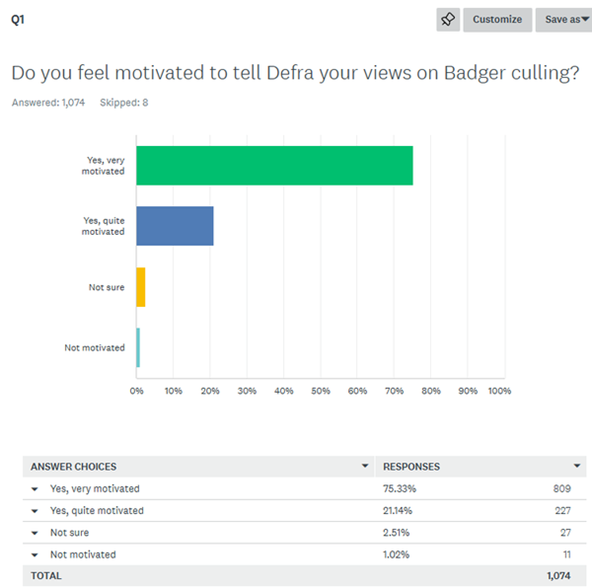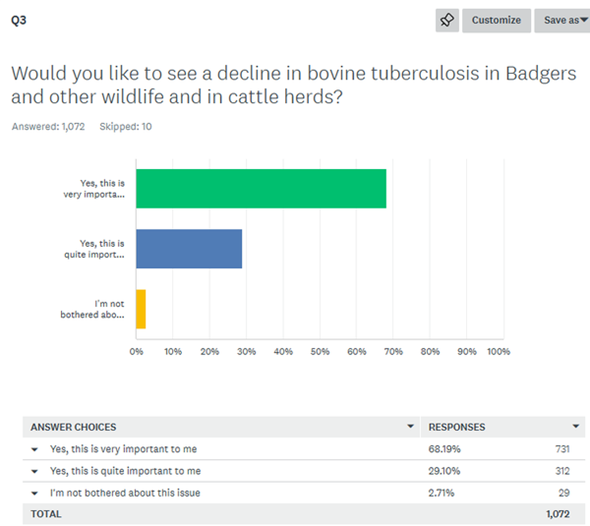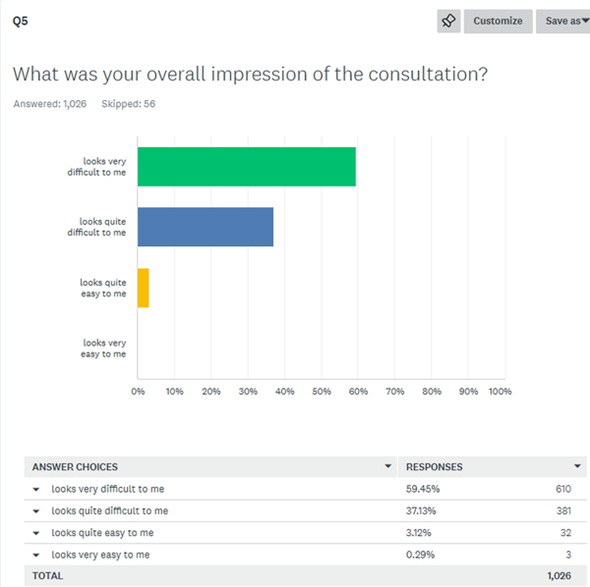The confusing Defra Badger consultation
On Friday morning we asked you to spend about 20 minutes reviewing the current Defra Badger cull consultation. We are very grateful to 1082 of you who completed that task: 715 on Friday, 145 on Saturday, 108 on Sunday, 107 on Monday and 7 on Tuesday. Here are the summarised results which we will be making available to Defra later today. Defra has said that it will respond to the letter sent by Wild Justice and the Badger Trust criticising the consultation by Friday so this is further input to their cogitation.
Question 1 – we asked about your motivation to respond to the consultation.

Question 2 – we asked whether you were keen on Badgers

Question 3 – we asked about your views on bovine tuberculosis

Question 4 – we asked about what factors would be important to you in assessing bovine tuberculosis control measures

Question 5 – we asked about your overall impression of the consultation

That’s the easy bit! The responders to the Wild Justice questionnaire were highly motivated to respond to this public consultation, they were keen on Badgers, keen to see a reduction in bovine tuberculosis in wildlife and cattle, thought that there were many aspects of the issue that would influence their views and thought the consultation looked very difficult to engage with.
Question 6 – the Defra consultation asks (in its question 5, on p17 of the consultation document) whether you agree with the ‘stated objective’ of a targeted badger intervention policy without stating what the stated objective might be:

We asked our respondents to look through the Defra consultation document and tell us on which page they believe that ‘stated objective’ was stated. 919 of you responded (92 skipped the question)
The commonest response was ‘Can’t find it’ – 462 respondents (50%)
Of those who indicated they found the ‘stated objective’ on a single page the breakdown was as follows:
Page 1………………….2
Page 4………………….3
Page 5………………….1
Page 6………………..23
Page 7………………..11
Page 8…………………3
Page 10………………14
Page 11………………..5
Page 12………………51
Page 13………………82
Page 14………………..4
Page 15………………..3
Page 16………………..2
Page 17……………….32
Of those who indicated they found the ‘stated objective’ on multiple but adjacent pages the breakdown was as follows:
Pages 3, 4, 5 and 6………………..1
Pages 4 and 5……………………….1
Pages 6 and 7……………………….1
Pages 6, 7 and 8……………………1
Pages 7 and 8……………………….5
Pages 10, 11 and 12………………1
Pages 12 and 13………………….17
Pages 12, 13 and 14………………2
Pages 12, 13, 14 and more……10
Pages 13 and 14…………………..3
An additional 11 respondents identified multiple non-adjacent pages as the location of the stated objective.
To summarise:
• half of our respondents could not find the ‘stated objective’ referred to in Defra’s question 5
• the other half of our respondents identified all but two (pages 2 and 9) preceding pages of the Defra questionnaire as being the location of the ‘stated objective’ i.e. pages 1,3,4,5,6,7,8,10,11,12,13,14,15,16 and 17.
• Wild Justice would plump for the top of page 13, in fact section 5.7, as being the ‘stated objective’ and if we are generous in including page 12 alongside page 13 as the ‘right’ answer then around 150 of our respondents agree with us – 150 is 16% of those who answered the question. This means that 84% of our respondents either could not find the ‘stated objective’ or thought that it was somewhere other than where we believe it might be.
This is not a sound basis for Defra to rely on the responses to their question 5.
Question 7 – we asked our respondents whether, having looked at Defra’s question 5, and looked for the stated objective, how easy would they find it to answer Defra’s question 5, right now.

Question 8 – we asked our respondents where the issue of costs was addressed. Most responses, to keep it brief, were highly critical and pointed out that the mentions of economic benefit and Value for Money did not state costs, and did not provide analysis of the figures given, nor comparative figures for alternative actions. One respondent stated that they were ‘losing the will to live’ after a quarter of an hour of trying to understand this public consultation paper.
Question 9 – we asked our respondents where the issue of humane killing was addressed. Most responses, to keep it brief, could not find any mention of it. Some pointed out that there were mentions on pages 19 and 20 of the consultation paper (and a few other scattered mentions) but that these were statements simply stating that the Chief Veterinary Officer regarded the current cull methods as humane (many of our respondents disagreed) or that culling would be humane.
Summary:
- The Wild Justice questionnaire did not deal with all unsatisfactory aspects of the Defra consultation paper. We did not ask about factual inaccuracies, misrepresentations or important omissions. We concentrated on whether the Defra consultation was understandable and represented a fair series of questions that could be answered by a motivated member of the public. We concentrated on Defra’s question 5, which we believed was important as it asked whether respondents were in favour of Defra’s plans, against them or needed more information.
- Defra’s question 5 asks respondents views on the ‘stated objective’ without being clear about the stated objective. The questions was asked on page 17 and our respondents thought that they had found the ‘stated objective’ on a wide selection of the 17 pages of the consultation preceding and including the question, but half of our respondents reported that they could not identify the ‘stated objective’. Our guess is that the stated objective had to be hunted down four full pages preceding the question about it – a horrendous way to structure a consultation.
- After being invited to think about Defra’s question 5 in our questionnaire, 63% of respondents said they would find it very difficult to answer Defra’s question 5 and another 24% reported that it would be somewhat difficult to answer. Thus almost nine out of 10 of our respondents would find Defra’s question 5, a crucial question one might think, difficult to answer even after being directed to it specifically.
- By inspection of the free text responses it is clear that this is partly because half of our respondents did not feel that they identified the stated objective, but also because the stated objective in section 5.7 has an element of ‘reducing bovine tuberculosis’ (which most people support) mixed up with increased Badger culling as the mechanism (which many people do not support). How is the public supposed to answer Defra’s question 5 if they want to reduce bovine tuberculosis but do not want badgers to be killed by free shooting OR do not want badgers to be killed OR do not think that badger killing is effective OR want to know the costs OR have a wide variety of other concerns.
- Wild Justice would not know how to answer Defra’s question 5 ourselves nor would we know how to recommend that others answer it. Defra’s question 5 cannot deliver useful or reliable information.
- The consultation lacks any meaningful information about other aspects of Badger culling eg cost and humaneness that are important to the decision making of many members of the public.
- We note that if a respondent doesn’t care much about Badgers and wants more culling, the Defra consultation is relatively easy to complete. This will create a massive bias in the responses gathered.
Wild Justice thanks over 1000 respondents to our questionnaire.
Wild Justice will make these findings available to Defra later today.
PS Thank you for all your message of support and donations following yesterday’s news of our legal victory over Defra over gamebird releases.
PPS The link to our questionnaire – click here – is open so that people can inspect the questions but we will not be adding any further responses to our analysis.
